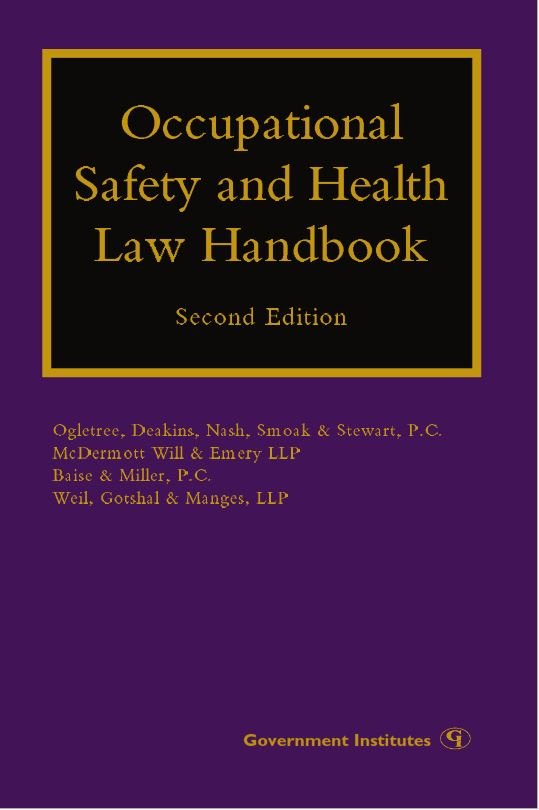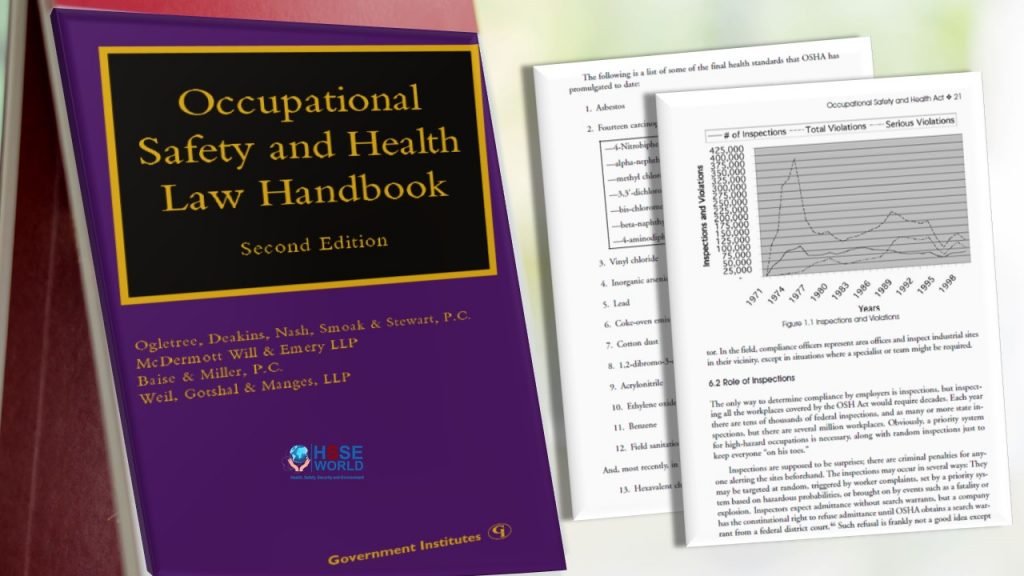E-Books: Occupational Safety and Health Law Handbook
4 min readOccupational Safety and Health Law Handbook By Melissa A. Bailey, Matthew C. Cooper, Frank D. Davis. The handbook begins with a review of the basic requirements of the law, who is covered, who is not, how safety and health standards are developed, how affected parties may participate, and how variances may sometimes be obtained when final standards conflict with other safety considerations at particular employment locations.
Nothing in the workplace is more important than employee safety and health.
Good safety and health conditions and practices are maintained by the dedication of all employees with the help of supervisors, management, and safety professionals. A major component of safety and health management is in compliance with the regulations and standards of the Occupational Safety and Health Administration
(OSHA) within the U.S. Department of Labor. This handbook provides important information regarding legal requirements and compliance responsibilities related to OSHA enforcement of safety and health requirements under the Occupational Safety and Health Act of 1970. All the authors of the handbook are experienced in occupational safety and health law. All are able to bring unique insights to the issues addressed. Together they provide in this handbook a comprehensive analysis of the issues that arise under federal and state OSHA programs. The handbook begins with a review of the basic requirements of the law, who is covered, who is not, how safety and health standards are developed, how affected parties may participate, and how variances may sometimes be obtained when final standards conflict with other safety considerations at particular employment locations.
The mechanism and details of enforcement are reviewed in the handbook, including those pertaining to jurisdiction, inspections, the authority of inspectors, citations, and monetary penalties. The implications of specific standards and the General Duty Clause established in the Occupational Safety and Health Act are analyzed.

Criminal law enforcement is also addressed. The rights of employers and employees are detailed and explained. These include rights to contest enforcement actions by the enforcing agency and protection of employees against unlawful discrimination related to protected safety activity.
Employee rights to know and employer recordkeeping and reporting obligations are also explained. All of these subjects are of critical importance to employers and employees. It is hoped that the users of this handbook will find themselves greatly aided in ensuring good safety and health compliance and as well as fair and even-handed enforcement by authorities.

Contents
The Contents of Occupational Safety and Health Law Handbook
- Chapter 1 Occupational Safety and Health Act
- Chapter 2 OSHA: The Rulemaking Process
- Chapter 3 The Duty to Comply with Standards
- Chapter 4 The General Duty Clause
- Chapter 5 Recordkeeping
- Chapter 6 Employers’ and Employees’ Rights
- Chapter 7 Refusal to Work and Whistleblower Protection
- Chapter 8 Hazard Communication
- Chapter 9 Voluntary Safety and Health Self-Audits
- Chapter 10 Inspections and Investigations
- Chapter 11 Understanding and Contesting OSHA Citations
- Chapter 12 Criminal Enforcement of Violations
- Chapter 13 Judicial Review of Enforcement Actions
- Chapter 14 Imminent Danger Inspections
- Chapter 15 OSHA-Approved State Plans
Download the book
More Downloads
- E-Books: Healthcare Hazard Control & Safety Management
- E-Books: Safety, Health and Working Conditions Training Manual
- E-Books: Energy Efficiency in Water and Wastewater Facilities
- E-Books: Fire Service Features of Buildings and Fire Protection Systems
- E-Books: Evaluation of Fire Safety free download
- E-Books: PPE for Chemical, Biological, and Radiological Hazards free
- E-Books: Changing the Workplace Safety Culture free download
- E-Books: Site Emergency Planning Workbook
- E-Books: Load Restraint Guide
- E-Books: Essential Practices for Creating, Strengthening, and Sustaining Process Safety Culture
- E-Books: System Safety Engineering and Risk Assessment
- E-Books: Permit-Required Confined Spaces
- E-Books: Is it Safe to Enter Confined Space?
- E-Books: 5-Minute Workplace Safety Talks
- E-Books: Safety Culture and High-Risk Environments
- E-Books: Practical Guide to Industrial Safety
- E-Books: Slip, Trip, and Fall Prevention for Healthcare Workers
- E-Books: Health and Safety at Work Key Terms
- E-Books: Fundamentals of Process Safety Engineering
- E-Books: Gas Detection Hand Book
- E-Books: Occupational health and safety management systems ANSI-AIHA-z10-2012
- E-Books: Hot Work on Drums and Tanks
- E-Books: Human Fatigue Risk Management
- E-Books: Guidelines for the provision of facilities and general safety in the construction industry
- E-Books: Handbook of Training in Mine Rescue and Recovery Operations ( 2021)
- E-Books: Code of Practice for the Safe Use of Lifting Equipment – Edition 9 (Nov 2019)
- E-Books: Free Forklift Health and Safety Best Practices Guideline
- E-Books: Handbook of Hazardous Chemical Properties
- E-Books: Human Performance Improvement through Human Error Prevention
- E-Books: Principles Of Fire Risk Assessment In Buildings
- E-Books: Investigation of Occupational Accidents and Diseases
- E-Books: Radiation Protection and Safety in Industrial Radiography
- E-Books: Basic Guide to System Safety, Third Edition
- E-Books: Food Safety Management-A Practical Guide for the Food Industry
- E-Books: Safety identification: Escape and evacuation plan signs- ISO 23601
- E-Books: Safety at Work
- E-Books: The Safety-Critical Systems Handbook 4th edition
- E-Books: Fundamental principles of occupational health and safety
- E-Books: Fire Safety Risk assessment Guide – Sleeping Accommodation
- E-Books: Mental health at work series
- E-Books: Live Fire Training: Principles and Practice
- E-Books: Pre-Startup Safety Review Guide
- E-Books: Fire and Emergency Drill Manual and Building Inspection Guide
- E-Books: Health and Safety: Risk Management 5th edition
- E-Books: Fire Protection systems -Third edition 2021
- E-Books: Fire Safety Logbook templates
- E-Books: From Accidents to Zero
- E-Books: Electric Safety Practice and Standards
- Your steps to chemical safety
- E-Books: Ergonomics and Psychology Developments in Theory and Practice
- E-Books: HAZOPS Should BE fun-The Stream-Based HAZOP
- E-Books: Safety Health and Environmental Auditing
- E-Books: A Quick Guide to Health and Safety
- E-Books: Occupational Ergonomics A Practical Approach
- E-Books: Job Hazard Analysis A Guide for Voluntary Compliance and Beyond
- E-Books: Electrical Safety of Low Voltage Systems



